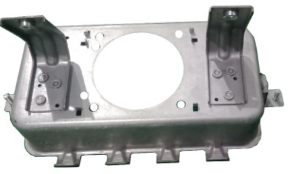Is gas-liquid supercharging cylinder an executive element? The answer is yes, let's answer this question in detail.
What is an actuator?
The executing element is the element that completes the control of the controlled object according to the control information from the controller. It converts electrical or fluid energy into mechanical energy or other forms of energy, and changes mechanical motion or other states (such as temperature, pressure, etc.). Control controlled objects according to control requirements. It acts directly on controlled objects and can act as "hands" and "feet".
In mechanical automation systems, actuators can be divided into three categories according to the input energy: electric, pneumatic and hydraulic. The electric actuator is flexible to install and easy to use. It is widely used in automatic control system. Pneumatic actuator simple structure, light weight, reliable operation, explosion-proof. Widely used in small and medium-sized power chemical and petroleum equipment and mechanical industry automation production line. Hydraulic actuator is widely used in high power control system for its advantages of high power, good rapidity and smooth operation.

Actuators are divided into pneumatic actuators, electric actuators and hydraulic actuators according to different applications.
1 cylinder pneumatic actuator is a kind of gas energy into mechanical energy to achieve reciprocating or rotating motion of the actuator. Pneumatic actuators that achieve linear reciprocating motion are called cylinders.
2. The hydraulic cylinder
Hydraulic actuators convert hydraulic energy into mechanical energy to achieve reciprocating or rotating motion. It is divided into hydraulic cylinder, swing hydraulic motor and rotary hydraulic motor.
So, is the gas-liquid supercharging cylinder an executive element?
Combined with the advantages of cylinder and hydraulic cylinder, the gas-hydraulic pressurized cylinder is improved. The gas-liquid booster cylinder is a hydraulic component that can convert the input gas pressure and output it at a higher pressure. Therefore, the gas-liquid booster cylinder is a pneumatic hydraulic actuator, that is to say, the gas-liquid booster cylinder is an actuator!
Gas-liquid supercharging cylinder is an integrated combination of hydraulic cylinder and supercharger, which uses the ratio of different compression cross-sectional area of supercharger and PASCAL energy saving principle. Because the pressure is constant, when the pressure area changes from large to small, the pressure will also change according to the principle of different sizes, so as to achieve the pressure effect of increasing the pressure dozens of times. Take THE JRA pre-pressurized gas-liquid booster cylinder as an example: when the working pressure is pressed on the surface of the hydraulic oil (or piston), the hydraulic oil will compress the air and flow to the pre-pressurized travel chamber. At this point, the hydraulic fluid will quickly push the part to discharge. When the working displacement encounters resistance greater than the pressure, the cylinder will stop working. At this point, the pressurizing chamber of the gas-liquid pressurizing cylinder will begin to pressurize due to the effect of electrical signals (or pneumatic signals), so as to achieve the purpose of forming products.